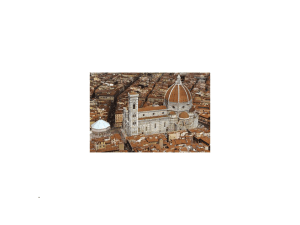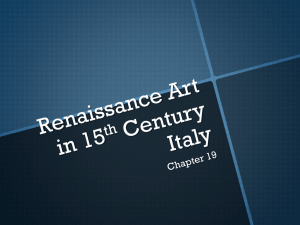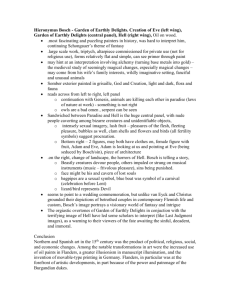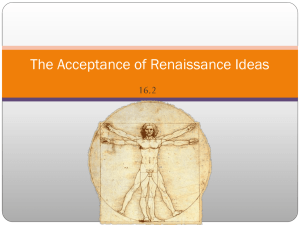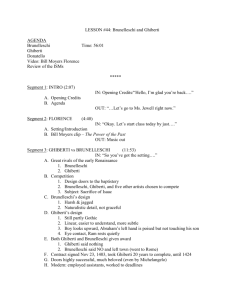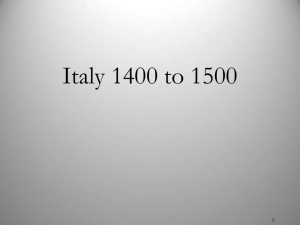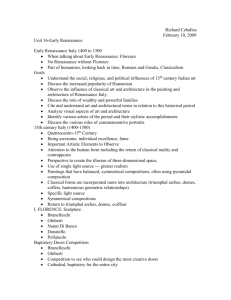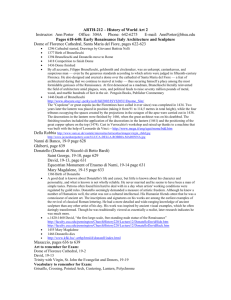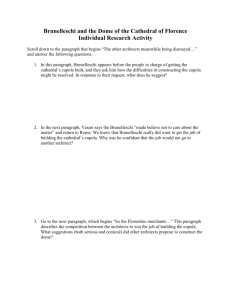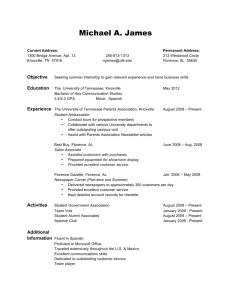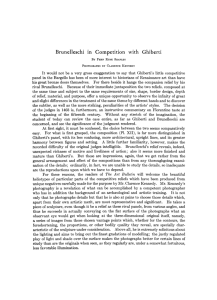Italian Renaissance
advertisement
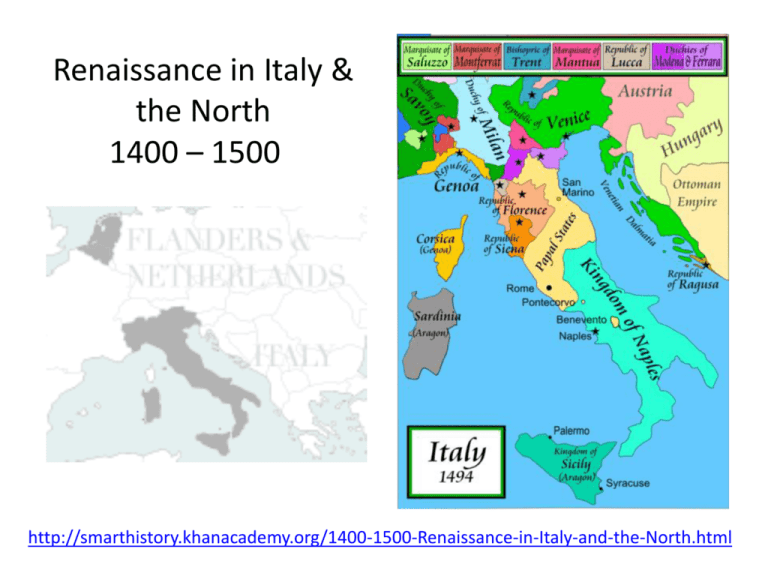
Renaissance in Italy & the North 1400 – 1500 http://smarthistory.khanacademy.org/1400-1500-Renaissance-in-Italy-and-the-North.html Competition Panels of the Florence Baptistery Eastern Doors Filippo Brunelleschi & Lorenzo Ghiberti, Sacrifice of Isaac, competition panels, Baptistery doors, gilded bronze relief, 1401-2 (Bargello, Florence) http://smarthistory.khanacademy.org/brunelleschi-ghiberti-isaac.html Ghiberti, Sacrifice of Isaac, 1401-3. (winning design) Panel is the “quatrefoil” or Gothic shape The competitors were expected to submit panels representing the Old Testament story of the Abraham's Sacrifice of Isaac. It depicts the moment when Abraham, ordered by God to sacrifice his only son, is about to plunge the knife into Isaac's neck, but his hand is stayed at the last moment by an angel. This story of divine delivrance would undoubtedly have resonated with Florentines, whose city had been delivered by the sudden death Gian Galeazzo Visconti in September of 1402. Ghiberti in his account of the competition records the name of seven competitors, all from Tuscany: Filippo Brunelleschi, Lorenzo Ghiberti, Jacopo della Quercia, Simone da Colle, Niccolò d'Arezzo, Niccolò di Pietro Lamberti, and Francesco di Valdambrino. Ghiberti, Sacrifice of Isaac • Designed for the second set of Florence Cathedral Baptistery • Competition used the same number of figures, same scene and quotation from the Bible • Gothic, Sienese in design: curve to the body of Abraham, fluttering of Abraham’s drapery behind arm • Idealized forms (vs. Brunelleschi’s expressiveness) • Polished effect • Decorative lines • No particular focus • Classical figure of Isaac inspired by Roman art • Abraham’s face taken from Roman model of Jupiter • Graceful poses • Made in two pieces, thus less expensive Brunelleschi, Sacrifice of Isaac • Commission given to Ghiberti after the success of the second set of doors • Doors use a more neutral and modern rectangular shape instead of more Gothic quatrefoil • Expansive and harmonious use of space • Elegant bodies • Creation of a precise spatial depth • One dense group of forms • Composition divided into two main tiers: upper and lower • Weighty figures • Great variety of poses • More dramatic, tense, sense of urgency • Youthful Isaac • Figures overlap boundaries of quatrefoil pattern • Figures inspired by Roman models • Made in eight pieces, much heavier than Ghiberti’s Brunelleschi, Dome of Florence Cathedral Dome of Santa Maria del Fiore http://smarthistory.khanacademy.org/brunelleschis-dome.html Italian Quattrocento Architecture Brunelleschi, Dome of Florence Cathedral • Dome is raised on a high drum, meant to be seen from the outside more than the inside, unlike the Pantheon or the Hagia Sophia • Semi-pointed, eight-sided dome • Built with no centering devices • Really two domes, the interior does the structural work, and the exterior gives it a soaring quality • Extremely wide width of 140’ to vault • Octagonal lantern on top: 8 buttresses with supports at the angles, each having a Corinthian pilaster; each buttress pierced by a classicizing portal-like opening Filippo Brunelleschi, Santo Spirito, Florence, 1428-81 http://smarthistory.khanacademy.org/brunelleschis-santo-spirito.html Michelozzo, Palazzo Medici, Florence Italian Quattrocento Architecture Michelozzo, Palazzo Medici, Florence • Three horizontal levels • 1st story: rough cut, rusticated stone, Roman fortress like, used for shops and businesses; later the arches were filled in; fortitude of inhabitants implied • 2nd story: smooth cut blocks, family quarters • 3rd story: smooth surface • Heavy cornice to limit vision and imply sense of strength • Façade does not support building, working towards a curtain wall • Modern bank image comes from this building 10 Italian Quattrocento Architecture Brunelleschi, Santo Spirito, Florence • • • • • • • • Early Christian basilica Unfluted Corinthian columns Flat coffered ceiling Floor has square patterns that divide up the space mathematically Added impost blocks for height Width of nave equals height of nave arcade Florentines thought geometric precision could decode the mysteries of the universe Light, airy, open Italian Quattrocento Architecture Alberti, Sant’Andrea, Mantua • Combination of Roman triumphal arch with antique temple front • Pairs of giant pilasters, topped by Corinthian capitals, support pediment • Large barrel vault that rises above the façade • Size of façade dictated by the small plaza in front of church: Alberti could not change width—bell tower on one side, the plaza on the other • Alberti sought to create identical proportions of width and height • “Ombrellone” seems awkward, but it creates a powerful barrel vault inside building, largest since antiquity 12 For Homework please view this architecture on Smarthistory, Pazzi Chapel http://smarthistory.khanacademy.org/brunelleschispazzi-chapel.html

